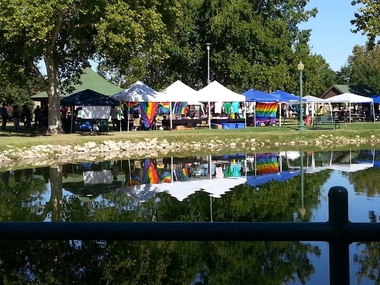What have you done today to make yourself proud?

Christopher T. Conner, Ph.D.
Washburn University
As May ends and Pride festivals begin, it is important now more than ever to understand what these festivals symbolize. While many individuals within our community feel as though the achievement of marriage equality marks the pinnacle of equality, there are a significant number who disagree.
In examining the history of LGBT+ persons it is my aim to encourage discussion and reflection on our shared political purpose. Everyone has a potential role to play in the restoration of LGBT+ politics and in the continued push away from injustice and towards justice.
Each June, LGBT+ persons all over the country gather to commemorate a legendary movement in their political liberation. While the origin story varies, most historians point to the summer of 1969 during which riots broke out all over the country as LGBT+ persons began to protest an overtly oppressive political system - most notably the police brutality and murder occurring in the streets.
The movement which crystalized in the wake of violence by radical LGBT+ protesters drew upon the strategies of the movements which had come before them: women’s liberation, black civil rights, the Vietnam war protests and other activists who collectively identified themselves as “the new left”.
These early organizations utilized Pride parades, marches, demonstrations and symbolic acts of resistance as a reaction to larger historical and political forces shaping their era. The LGBT+ persons living in this era were galvanized by a shared affinity for each other born out of their experiences.
Using the ideas of liberation and prideful acceptance of one’s identity signified an era of newfound freedom as well as increased internal fragmentation.
While the strategies of the 1960s were successful in gaining some basic human rights, some internal arguments were left unresolved. These included debates on just ‘whose community,’ or whose notion of community, took precedence. To resolve this issue, and preserve some internal sense of identity, new configurations of identity (or subcultures) began to emerge.
Among gay men, there were groups like “leather men” and “clones”, for example. These divisions further entrenched themselves in the 1980s as debates raged over organizing strategies to fight the AIDS crisis.
Today’s LGBT+ movement is the result of the historical and political controversies in previous decades. The critique that Pride has lost its original political purpose may indeed be a valid one.
As a sociological phenomenon, however, Pride still contains within it an important function for LGBT+ persons - the celebration in one’s identity, giving visibility and voice to the marginalized and providing a safe space to gather. In areas where there are few protections and less acceptance of LGBT+ people, Pride events attract many who live in rural communities and seek a momentary relief from their daily struggle.
Indeed, people in these areas are keeping the promises of Pride alive, for it is here where Pride and ultimately the validation of oneself (the true purpose of Pride) through identification with other likeminded people is most needed, appreciated and found wanting.
While we have garnered more freedoms, rights and privileges as a community - the cost has been one of increased fragmentation and isolation. We have created new images for the purposes of differentiating ourselves based on heteronormative (straight) standards of aesthetic beauty among other things.
As you go about participating in Pride festivals, remember that validation through prideful celebration is meaningless if we do not also take the time to continue to resist the forces of oppression both external and internal, as we have more to lose now than ever.
Christopher T. Conner is an assistant professor of sociology at Washburn University. He is a frequent contributor to LGBT+ media outlets.
Copyright 2017 The Gayly - 6/22/2017 @ 7:47 a.m. CDT





